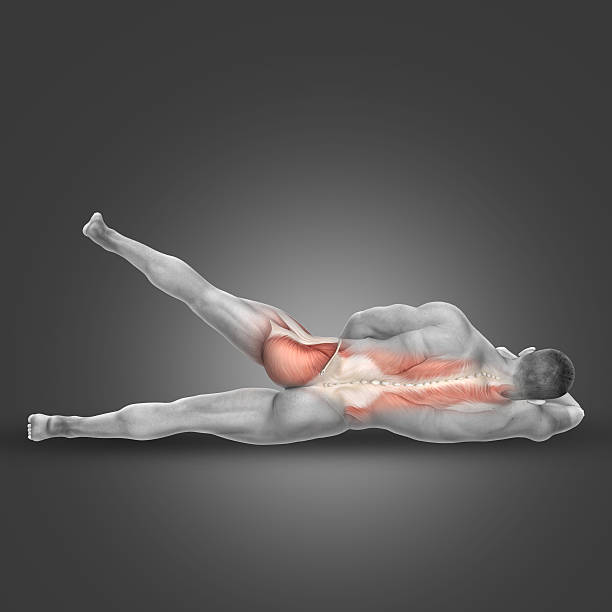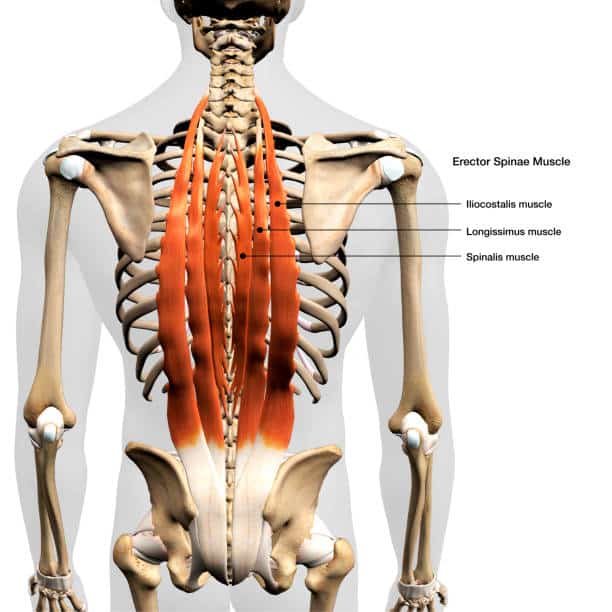
Strengthen Your Back with Erector Spinae Muscles Workout
Did you know that an estimated 75-85% of Americans will face lower back pain at some point in their lives? This underscores the importance of an effective erector spinae muscles workout for spinal support and overall back health.
Strengthening your back is vital for everyone, not just athletes. Whether you’re aiming to enhance your lower back workout or prevent future discomfort, focusing on your erector spinae muscles can significantly impact your well-being.
In this article, we’ll explore powerful back-strengthening exercises designed to target these essential muscles, helping you reduce injury risk and boost overall health. Let’s get started!
The Importance of Erector Spinae Muscles

Understanding the importance of your erector spinae muscles is key to maintaining a healthy spine. These muscles are crucial for keeping your spine upright and supporting various movements.
The erector spinae muscles are a group of deep, vertical muscles running along each side of the spine. A strong erector spinae muscle group enables essential back movements like flexion and rotation, which are vital for everyday activities.
One major benefit of having strong erector spinae muscles is improved posture. Good posture not only enhances your appearance but also reduces the risk of back pain and other spinal issues. Conditioning these muscles contributes to better spinal health.
Conversely, a sedentary lifestyle can weaken the erector spinae muscles, leading to poor posture and an increased risk of back injuries. Regularly exercising to strengthen these muscles can counteract these issues and provide significant posture benefits.
| Function | Impact |
|---|---|
| Maintaining upright posture | Reduces risk of back injuries |
| Flexion and rotation of the back | Enables daily activities with ease |
| Support for spinal movements | Enhances overall mobility |
| Regular conditioning | Improves spine health and posture benefits |
Erector Spinae Muscles Workout

Effective preparation is essential for a successful workout. Incorporating dynamic stretching and mobility drills can boost blood flow and prepare your body for more intense exercises. Begin with a comprehensive back warm-up routine to minimize the risk of injury and ensure a safe, effective workout.
Warm-up Exercises
- Cat-Cow Stretch: This yoga pose helps increase spine flexibility.
- Dynamic Spinal Rotations: Improve your range of motion and minimize stiffness.
- Bridges: Activate your glutes and lower back for a strong foundation.
Strengthening Exercises
Resistance training is crucial for developing stronger erector spinae muscles. Focus on exercises that specifically target your back muscles, and pay close attention to your form to avoid injuries and maximize effectiveness.
- Deadlifts: Utilize weights for back strength, ensuring your back remains straight throughout.
- Supermans: Improve lower back strength by mimicking a flying position.
- Good Mornings: Enhance hamstring and lower back flexibility while targeting the erector spinae muscles.
Cool Down and Stretching
Cooling down properly is just as crucial as the workout itself. Incorporate recovery exercises and back stretches to aid in muscle relaxation and enhance flexibility. These practices will support efficient recovery and prepare your back for future workouts.
- Child’s Pose: A gentle stretch for the spine, aiding flexibility improvement.
- Knee-to-Chest Stretch: Relieve any lower back tension accumulated during workouts.
- Pigeon Pose: Open up your hips and stretch the eri-spine effectively.
Benefits of a Strong Back
A strong back provides numerous benefits, such as better posture, improved back alignment, and reduced fatigue. Developing your erector spinae muscles is key to maintaining a straight spine and preventing slouching.
Improved Posture
One major benefit of strengthening your back is enhanced posture. A well-aligned spine can alleviate common issues like back pain and fatigue. Incorporating anti-slouching exercises can correct poor habits and strengthen the back muscles essential for good posture. Strong erector spinae muscles play a direct role in achieving effective spinal alignment.
Enhanced Core Stability
Core stability is crucial for overall body balance and strength. A strong back supports your core muscles, making daily movements smoother and more efficient. This improved trunk stability forms the foundation for physical activities, enhancing balance and reducing injury risk. Strengthening your back offers ergonomic benefits that go beyond appearance, providing practical advantages in everyday life.
Common Mistakes to Avoid
Achieving your fitness objectives and preventing injuries during erector spinae muscle training depends on avoiding frequent workout mistakes. The following are some errors you should avoid:
- Poor Posture: Keeping a proper technique is paramount. Ensure your spine remains neutral to prevent excess strain.
- Overtraining: Pushing your limits can lead to fatigue and injuries. Give your muscles ample time to recover.
- Lack of Warm-Up: Skipping a warm-up can make you more prone to injuries. Begin with light exercises to prepare your muscles.
- Ignoring Pain: Pain during your workout isn’t a positive sign. Adjust your form or stop to avoid serious injuries.
You may prioritize preventing injuries and preserve appropriate technique during your workouts by being aware of these common mistakes. This strategy guarantees long-term success while also improving your performance.
My Routine for Erector Spinae Muscles Workout

In my workout plan, I’ve developed a routine that effectively targets my erector spinae muscles. Over time, I’ve refined this regimen through consultations with fitness experts and some trial and error. This journey has significantly boosted my back strength.
One of my go-to exercises is the deadlift. I begin with a light warm-up, focusing on loosening my back muscles and gradually increasing the weight while maintaining strict form to avoid straining my back. I also include planks and back extensions in my routine. These exercises not only strengthen my back but also engage my core.
Stretching is crucial at the end of each session. I dedicate at least ten minutes to cooling down, concentrating on hamstring and lower back stretches. This practice helps prevent injuries and improves flexibility.
A piece of practical advice: listen to your body and avoid rushing. Personal workout plans should evolve with your fitness journey. Consistency and proper technique are key. By sharing my routine, I hope to inspire you to refine your own and achieve impressive results.
FAQ
What are the best back-strengthening exercises?
Some of the most effective back-strengthening exercises are deadlifts, rows, back extensions, and planks. These moves specifically target the erector spinae muscles and other crucial back muscle groups, providing comprehensive support for the spine and enhancing your lower back workout. Incorporating these exercises into your routine can help improve posture, reduce the risk of injury, and alleviate existing back discomfort. As some of the best exercises for your back, they also engage supporting muscle groups, creating a balanced and stable core. Consistency in performing these movements is key to building strength and maintaining a healthy, resilient back.
Why is spinal support important for overall health?
Spinal support is essential for maintaining proper posture, minimizing the risk of back pain and injury, and ensuring effective body function. A strong spine enhances daily activities and boosts overall well-being.
Can strengthening the erector spinae muscles improve posture?
Yes, strengthening the erector spinae muscles can greatly enhance posture. These muscles support spinal alignment, reducing the likelihood of slouching and contributing to a healthy, upright stance.
How often should I perform lower back workouts for optimal results?
It’s recommended to perform lower back workouts 2-3 times per week, ensuring you allow for sufficient rest and recovery. Each session should include warm-up, strengthening, and cool-down for minimal results.
What are some effective warm-up exercises for back workouts?
Effective warm-up exercises for back workouts include dynamic stretching, mobility drills like cat-cow stretches, and gentle routines such as arm swings and thoracic twists. These activities boost blood flow and prepare the back muscles for more intense exercise.
Are there specific cooling down and stretching exercises recommended post-workout?
Yes, post-workout cooldown are essential. Recommended exercises include child’s pose, seated forward bend, and lying spinal twists. These recovery moves help relax the muscles, improve flexibility, and prevent injury.
How do strong erector spinae muscles contribute to core stability?
Strong erector spinae muscles support the spine, enhancing trunk stability. This connection ensures better core muscle engagement, which improves balance and overall body strength.
What are common workout errors to avoid during back exercises?
Common workout errors include improper form, lifting excessive weight too soon, and skipping warm-up and cool-down routine training. Using proper technique is crucial to prevent injury and maximize the benefits of your back workouts.
Can you share your workout plan for the erector spinae muscles?
Absolutely! My workout plan for the erector spinae muscles includes deadlifts, hyperextensions, and dumbbell rows. I follow a structured warm-up before starting and a proper cool-down routine.



